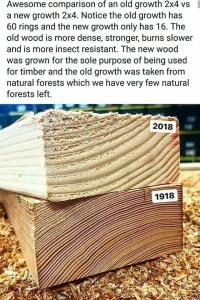-
Welcome to The Building Code Forum
Your premier resource for building code knowledge.
This forum remains free to the public thanks to the generous support of our Sawhorse Members and Corporate Sponsors. Their contributions help keep this community thriving and accessible.
Want enhanced access to expert discussions and exclusive features? Learn more about the benefits here.
Ready to upgrade? Log in and upgrade now.
You are using an out of date browser. It may not display this or other websites correctly.
You should upgrade or use an alternative browser.
You should upgrade or use an alternative browser.
Wood Density
- Thread starter mark handler
- Start date
steveray
SAWHORSE
The "new wood" blockhead customers I deal with are more dense...
mark handler
SAWHORSE
Inspector Gadget
REGISTERED
References?
mark handler
SAWHORSE
For stupidity?References?
mark handler
SAWHORSE

Wood density reduced while wood volume growth accelerated in Central European forests since 1870
Forest stand growth dynamics in Central Europe have accelerated since 1870 due to a rise in temperature, extended growing seasons, and other component…
 www.sciencedirect.com
www.sciencedirect.com
USGS Publications Warehouse
We studied the ages and diameter growth rates of trees in former Douglas-fir (Pseudotsuga menziesii (Mirb.)Franco) old-growth stands on 10 sites and compared them with young-growth stands (50-70 years old, regenerated after timber harvest) in the Coast Range of western Oregon. The diameters and...
Inspector Gadget
REGISTERED
A meme is not fact. If you're going to present something as being fact, I'd like to see some other resource cited for verification.For stupidity?
Paul Sweet
SAWHORSE
Ironically the top one would still be rated as Dense (more than 6 annual rings per inch)!
mark handler
SAWHORSE
Am I presenting it as a fact, or just a conversation starter....A meme is not fact. If you're going to present something as being fact, I'd like to see some other resource cited for verification.
That worked. People need to know that you are an architect... so you still retain some sense of humorconversation starter
Yankee Chronicler
REGISTERED
The fact that replanted, managed forests produce trees with wider (less dense) growth rings has been acknowledged for decades. When I first started "practicing" architecture in the early 1970s (because we never seem to quite get it right), it was accepted lore that Douglas Fir was the best, strongest dimension lumber available. And then, somewhere around 1980, the lumber industry came out with new grading rules and new span tables, and by some miracle hem-fir had magically become "better" than Douglas Fir (longer allowable spans, grade-for-grade) for the same loads. This has since pretty much gone back to closer to where it was, but for a while there it was difficult for anyone to understand how Douglas Fir had suddenly been displaced as the strongest framing lumber species.
At the time this happened, one of the structural engineers the firm I worked in used was also a professor of engineering at a local university. I discussed tis with him at the time, and his explanation was all about the difference between old-growth vs fast-growth timber.
At the time this happened, one of the structural engineers the firm I worked in used was also a professor of engineering at a local university. I discussed tis with him at the time, and his explanation was all about the difference between old-growth vs fast-growth timber.
steveray
SAWHORSE
And I was taught DF laying down and spruce standing up.....
mark handler
SAWHORSE
That's probably due to the fact that we do not have spruce, in abundance, on the west of the Mississippi.And I was taught DF laying down and spruce standing up.....
A lot of our lumber on the west coast comes from Canada.
Paul Sweet
SAWHORSE
Allowable stresses in Southern Pine keep decreasing because the newer fast-growing wood has more defects and a greater variation in strength for the same visual grade.
I saw an article which said (if I remember right) that the design stress is what 85% of the wood has to exceed, and that even though the mean strength is the same there is more weaker wood so the allowable stress was decreased.
I saw an article which said (if I remember right) that the design stress is what 85% of the wood has to exceed, and that even though the mean strength is the same there is more weaker wood so the allowable stress was decreased.
Am not clear where this 85% is coming from.
While the allowable stresses are influenced by the density of the species, the codified allowable stresses are clearly defined. The capacity of a member is controlled by the codified allowable stresses and the code specified factors related to duration.
Once you understand the grade of the lumber it is not necessary to be concerned about the density of the member.
While the allowable stresses are influenced by the density of the species, the codified allowable stresses are clearly defined. The capacity of a member is controlled by the codified allowable stresses and the code specified factors related to duration.
Once you understand the grade of the lumber it is not necessary to be concerned about the density of the member.
Yankee Chronicler
REGISTERED
I'll go so far as to say that you don't even have to understand the grade of the lumber. All we need to know as code officials is that lumber has grades, the code and reference standards have tables that spell out the parameters for the load/stress limitations on each speciaes and grade, and all dimension lumber and wood structural panels must have a stamp indicating the species and grade. Leave the rest of it to the structural engineers.
Paul Sweet
SAWHORSE
I was wrong about 85%, it's actually 95% has to exceed the design value according to an article "Effect of Variability on Lumber Design Values" by Don Bender & Frank Woeste that I downloaded from https://framebuildingnews.com shortly after the latest Southern Pine values were established.
But what do the adopted regulations require. An article may make an argument but it is not a legal regulation.I was wrong about 85%, it's actually 95% has to exceed the design value according to an article "Effect of Variability on Lumber Design Values" by Don Bender & Frank Woeste that I downloaded from https://framebuildingnews.com shortly after the latest Southern Pine values were established.
Yankee Chronicler
REGISTERED
But what do the adopted regulations require. An article may make an argument but it is not a legal regulation.
The codes don't dictate lumber grading rules -- the respective lumber grading agencies do that. The agency that sets the grading standards for Southern Yellow Pine is the Southern Pine Inspection Bureau.
The grading agencies do not have authority to adopt laws. It is only after the grading rules have been incorporated into the NDS which is incorporated into the building code that grading rules have the force of law.. Until that time the grading rules are recommendations.The codes don't dictate lumber grading rules -- the respective lumber grading agencies do that. The agency that sets the grading standards for Southern Yellow Pine is the Southern Pine Inspection Bureau.
Yankee Chronicler
REGISTERED
The grading agencies do not have authority to adopt laws. It is only after the grading rules have been incorporated into the NDS which is incorporated into the building code that grading rules have the force of law.. Until that time the grading rules are recommendations.
Correct, but it amounts to the same thing. The code does not specify wood strength or any grading criteria. Those are established by a process outside of and separate from the code, and adopted by reference.
Paul Sweet
SAWHORSE
"But what do the adopted regulations require. An article may make an argument but it is not a legal regulation."
The article wasn't trying to establish a regulation. It was just trying to explain why the SPIB adopted a new set of design values (which were generally lower than the previous ones) because newer visually graded lumber had greater variation in strength than older lumber.
Please PM me If you would like to see a copy of the article and I can e-mail it to you.
The article wasn't trying to establish a regulation. It was just trying to explain why the SPIB adopted a new set of design values (which were generally lower than the previous ones) because newer visually graded lumber had greater variation in strength than older lumber.
Please PM me If you would like to see a copy of the article and I can e-mail it to you.
Inspector Gadget
REGISTERED
As an aside, I had rough-cut lumber for my construction. It was overseen by a trained lumber grader, and then the structural elements verified by an engineer. Assisting the lumber-grader was quite insightful....The codes don't dictate lumber grading rules -- the respective lumber grading agencies do that. The agency that sets the grading standards for Southern Yellow Pine is the Southern Pine Inspection Bureau.


